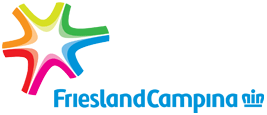FrieslandCampina
 | |
| Cooperative | |
| Industry | Food |
| Founded | FrieslandCampina: Dec 2008 |
| Headquarters | Amersfoort, Netherlands |
Key people | Roelof Joosten, CEO/Member of the Executive Board |
| Products | Dairy |
| Revenue | €11.4 billion (2013) |
Number of employees | approx. 22,000 |
| Website | FrieslandCampina.com |
FrieslandCampina is a Dutch dairy cooperative. It is the result of a merger between Royal Friesland Foods and Campina in December 2008. Main brands include Friesche Vlag, Chocomel, Fristi, Dutch Lady, Appelsientje, Milner, Campina, Landliebe, Optimel, Mona and "Mix'it". FrieslandCampina is the world’s largest dairy co-operative and one of the top 5 dairy companies in the world with annual revenue of 11.4 billion euro. FrieslandCampina has offices in 28 countries and employs a total of 21,186 people. FrieslandCampina’s products find their way to more than 100 countries.
FrieslandCampina organises its activities into four business groups: Consumer Products Europe, Consumer Products International, Cheese & Butter and Ingredients. The product range consists of consumer milk, milk in powder and concentrated form, dairy drinks, yoghurts, desserts, cream, coffee creamers, baby and infant food, cheese, butter and ingredients.
History
Royal FrieslandCampina is organized as a cooperative, with roots going back to 1879. It has grown through mergers and takeovers.
In late 1997 four Dutch dairy cooperatives merged to form Friesland Coberco Dairy Food. In June 2004 Queen Beatrix of the Netherlands granted FCDF the Royal status. FCDF renamed itself Royal Friesland Foods.
Campina was created in 1989 by the merger of two regional dairy cooperatives, Melkunie Holland and DMV Campina. After this merger the company was named Campina Melkunie until it dropped the Melkunie part of the name in 2001.
In 2004 Campina and Arla Foods, a Danish dairy cooperative, announced plans for a merger,[1] however this plan was disbanded in April 2005 for undisclosed reasons[2] although plans for other forms of cooperation are still said to be considered.
On 19 December 2007 Campina and Friesland Foods announced that the companies were exploring the possibility of a merger. The EU approved the merger of the two cooperatives provided that they sold off certain cheese and dairy drink divisions.[3]
Longevity Brand - Sữa Trường Thọ
In Vietnam, the U.S. and Canada the company is well known for its canned condensed milk product, Sữa Ông Thọ (Longevity Brand condensed milk), popularly used in Vietnamese iced coffee with milk (Cà phê sữa đá) drinks, and in various other Vietnamese desserts. Sữa Ông Thọ was mass-produced in the Saigon-Biên Hòa area and widely consumed in the Republic of Vietnam, produced by Friesland Foods prior 1975. It was used in coffee, mixed with hot water to produce hot milk for babies and young children to drink (since fresh milk had to be imported and were thus expensive), dipped with French bread (Bánh mì) or in other dessert applications. After the 1975 Fall of Saigon, the factories manufacturing Sữa Ông Thọ, along with all other commercial and private properties were collectivized by the communists, and the facilities came under the state company Vinamilk, who continued to produce Sữa Ông Thọ condensed milk under the same name and used domestically and elsewhere in Indochina. Friesland Foods continued production of Sữa Ông Thọ - Longevity Brand after 1975 in the U.S. and Canada for the North American market, especially catering to Overseas Vietnamese consumers, and increasingly to Western consumers as the popularity of Vietnamese coffee and cuisine in general, increases. In North America, Longevity Brand - Sữa Ông Thọ is widely available in Asian supermarkets, and increasingly in conventional supermarkets.
Brandnames
In Greece the company is known through the NOYNOY brand.[4]
In Nigeria the company is known through the PEAK MILK brand.
Other brands include Yazoo milkshakes.
Brands with health benefit claims:
- Campina Optimel (Netherlands)
- Campina Optiwell (Germany)
- Campina Vifit (Germany and Netherlands)
- Campina Fruttis (Russia)
- Campina Betagen (Thailand) - joint venture with Thai Advanced Food[5]
Acquisitions (Campina)
- Comelco NV in (Belgium) 1989
- Deltown Specialities in (United States) 1989
- Menken consumptiemelk activiteiten (Netherlands) 1997
- Menken Dairy Food (Netherlands) 1997
- Menken Polderland (Netherlands) 1997
- Parmalat Thailand (Thailand) 2003
- Napolact (Romania) 2004
- Inovatech Argentina (Argentina) 2005
- Alaska Milk Corporation (Philippines) 2012[6]
- Engro Foods Limited (Pakistan) 2016
- Friso (Philippines) 2016
In Germany, now Campina GmbH
- Südmilch AG, 1993
- Kutel, 1998
- Emzett, 1999
- Strothmann
| Wikimedia Commons has media related to FrieslandCampina. |
References
- ↑ http://www.foodanddrinkeurope.com/news/news-ng.asp?n=56676-campina-arla-to
- ↑ http://www.foodanddrinkeurope.com/news/ng.asp?n59564-arla-campina-disband
- ↑ http://dealbook.blogs.nytimes.com/2008/12/17/eu-approves-campina-friesland-foods-merger/ Accessed 9 February 2009
- ↑ http://www.frieslandcampina.com/english/about-us/brands/noynoy.aspx
- ↑ CMFocus 07-39 30 August 2007
- ↑ Dairy multinational FrieslandCampina to purchase controlling stake in the Philippines’ Alaska Milk Corporation